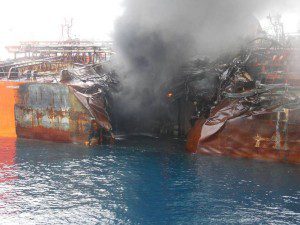Posted - February 12, 2014 -
By Keith Wallis - Reuters
A fire-ravaged ship loaded
with hazardous chemicals has become a maritime football in the
north Pacific, with
Japan and
South Korea unwilling to give it
refuge even though they risk a wider environmental disaster if
it sinks.
The plight of the Maritime Maisie, a chemical tanker which
has spent seven weeks being towed in waters between the two
Asian neighbours, highlights the lack of global consensus on
designating ports as safe-havens for ships in distress.
The two countries are worried about the risk of a spill or
environmental pollution at port, sources said.
The tanker, a 44,000 deadweight-tonne vessel the size of
nearly two football fields, collided with another ship nine
nautical miles off Busan,
South Korea, on Dec. 29, said Ying
Jinghua, fleet director of MSI Ship Management, which manages
the tanker's day-to-day operation, and other shipping sources.
The accident caused a fire when a cargo tank holding the
chemical acrylonitrile ruptured. The ship, owned by Aurora
Tankers, part of Singapore's IMC Group, was carrying 29,337
tonnes of acrylonitrile, used to make plastics and synthetic
rubber, and other chemicals, Ying and the sources said.
The 27 crew on the tanker were rescued and the ship, ablaze
until Jan. 16, drifted into Japanese territorial waters before
tow lines could be secured. About 20,000 tonnes of chemicals and
640 tonnes of heavy fuel oil still remain onboard the ship, two
sources with knowledge of the incident said.
The Hong Kong-registered ship has been towed between South
Korea and Japan since Dec. 30 amid efforts to persuade either of
the countries to provide a place of refuge, where its remaining
cargo could be safely offloaded to another ship.
Despite approaches by the Hong Kong government's Marine
Department, salvage teams and the ship's management company, the
South Korean and Japanese governments have yet to yield.
Shipping executives, including representatives from salvage
company Nippon Salvage, will meet with Korean and Japanese
officials in the next two days to further discuss a place of
refuge for the tanker, Ying of MSI Ship Management said.
South Korea and Japan are members of the International
Maritime Organisation (IMO), a
United Nations body that adopted
non-binding guidelines on places of refuge for ships a decade
ago.
The IMO move came after a number of ships, notably in
Europe, broke up and sank causing extensive pollution when
countries refused to provide a safe berth.
These included the oil tanker Prestige that broke up and
sank off the coast of Galicia,
Spain, in November 2002, spilling
60,000 tonnes of oil and polluting almost 3,000 kilometres of
coastline.
"Member states are failing to meet the spirit of their
obligations," said Tim Wilkins, Asia Pacific regional manager
with tanker owners lobby group INTERTANKO.
'LOCAL CONCERNS TAKE PRECEDENCE'
Hong Kong's Marine Department wrote to South Korea's
Ministry of Oceans and Fisheries seeking a refuge for the ship
for the second time earlier this month, said Stephen Li, Marine
Department senior surveyor.
The department has yet to hear a response, while Japan has
already declined to help, Li told Reuters.
The Japanese Coast Guard said they could not comment
immediately.
"The Korean government is discussing how to deal with this
matter and nothing has been decided," an official at the
country's Ministry of Oceans and Fisheries with direct knowledge
of the matter told Reuters.
The ministry told Hong Kong's Marine Department a month ago
Japan was obliged to offer a suitable place to transfer cargo
and fuel because the tanker drifted into Japanese territorial
waters.
Once the chemicals and fuel were offloaded, the ministry
said South Korea could talk about allowing the ship into Korea
for repairs, the source with knowledge of the incident said.
Comité Maritime International, a Belgian umbrella group of
maritime law organisations, floated proposals in 2009 to create
a binding IMO convention on places of refuge.
But the UN's IMO rejected it, saying other measures -
including a Nairobi convention on the removal of wrecks which
comes into force in 2015 - were sufficient.
The place of refuge issue in Asia will figure prominently at
a meeting next month of the Asian Shipowners' Forum, which
represents Asian shipowner groups, said Arthur Bowring, managing
director of the Hong Kong Shipowners' Association.
"The (IMO) guidelines are only guidelines. Local politics
and concerns take precedence and it becomes difficult" to
implement them, said Bowring.
(Additional reporting by Meeyoung Cho in SEOUL and Osamu
Tsukimori in TOKYO; Editing by Muralikumar Anantharaman)
Post to be found at:
http://www.reuters.com/article/2014/02/12/tankerrefuge-idUSL3N0I72ZU20140212




 ShareThis
ShareThis




